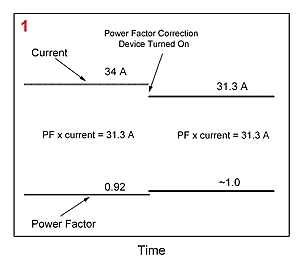Home › Electrical Engineering Forum › General Discussion › Are Power Factor Correction Units Necessary For Residential Consumers? (Debate)
- This topic has 4 replies, 3 voices, and was last updated 9 years, 9 months ago by
Anonymous.
-
AuthorPosts
-
2014/12/08 at 10:51 am #11217
admin
KeymasterFew weeks ago, we received this debate from Martin M., one of the visitor of the blog. So here is his interesting opinion on Power Factor Correction…
You too can send us a mail if you want to create a debate on the topic of your choice.
You may have come across a nice, clear video on the importance of purchasing Power Factor Correction (PFC), also known as KVAR units for residential consumers. You may be luckier and actually met a salesperson, all verbose on how you can save a lot of money by installing a simple device between the power supply and the home appliances.
The selling point implicitly relies on people’s ignorance, as well as well laid-out misinformation and skewed facts. The main selling points for the scammers include the following
- Home appliances such as refrigerators and washing machines are induction equipment and thus draw reactive power from the system.
- Many industries use the PFC units to save energy, and so should you.
- There are a number of positive ‘testimonials’ from satisfied clients.
My Take
In my opinion, this is just a huge swindle. For starters, in most residential buildings, the power supply is split into two distinct sections, the tenant power supply, and the house service supply. The former supplies power to the individual units for regular home use such as lighting, home appliances and supplementary air conditioning.
The house service section on the other hand powers the central air conditioning unit, escalators and external lighting. The items are residential grade, and therefore do not draw any significance reactive power. Do note the following:
- The power factor for this section is already past 0.90 so no need to improve
- Most of the housed appliances are resistive rather than inductive loads. These include heaters, ovens, and refrigerators.
- Tenant power costs are billed by the kWh used, or real power, thus reactive power never comes into play. The residential meter is designed to ignore the reactive power drawn from the system, by virtue of the fact that is negligible. This means that the PFC units are useless additions.
- Most of the home appliances already have integrated PFC units for compliance with industrial standards and energy efficiency
To expound more on this point, it is a fact that some home appliances have small motors, for example washing machines. Motors are inductors, and thus draw reactive current from the system.
However, considering that the amount is negligible, and the meters are designed to ignore this value, there is absolutely no need to purchase the PFC units. In essence, when you purchase the unit, all you are doing is helping the power supply company by relieving extra load current from the system.
There are a number of residential loads that significantly decrease the power factor. This includes the HVAC unit, refrigerators, and washing machines due to the integrated motors. Do note that these are not used continuously, like would motors in continuous line manufacturing industries.
Installation of a PFC unit will increase the power factor, thus leading to reduced current draw from the system. However, do note that the residential bill amount is a product of the voltage, current, and pf.
Cost=Current X Voltage X PF
Thus by reducing the current drawn form the system and increasing the pf, the product essentially remains the same, as highlighted in the figure.
To further develop my point, there is a need to briefly highlight why industries using LV and MV systems require the PFC units. The commercial meter is different from the residential meter. It has two dials, one for the kWh, and the other for kVA. The kVA is the reactive power.
Induction motors and other industrial equipment require reactive power to run. The power utility company requires more current to sustain the standard load in the presence of significant reactive power. Thus, if the reactive power exceeds a third of the real power, the industry accrues a charge.
In my opinion, and based on the above information, PFC units are worthless for regular residential consumers. Perhaps the manufacturers should change their pitch, and instead focus on the effects on the environment from resources used to manufacture the PFC units, and thus impress on the residential clients to purchase the units, just to help reduce the power supply company’s carbon print.
This was my opinion on this subject but I’d really like to know what’s yours. So tell me below what do you think about it?
Martin M.
2014/12/29 at 3:27 pm #13637Anonymous
GuestI agree with Martin. Actually, modern household load also comrises of digital electronic devices which genrate harmonics. The load harmonics will deteriorate the power factor. Adding the capacitor to such service will amplify the harmonics and chances are that cables will be heated more and pf will further decrease. Thi migh affect the elecrical bill adversely. Hence it is not good for residential consumers. Even for a commercial consumers, it is better to estimate the need and buy the required capacitors alongwith its switching device rather than such fixed blackboxes. Engineered device work, magical ones may not!
2014/12/30 at 11:50 am #13638Anonymous
GuestI fully agree with Martin.
Only one mis-typing to be corrected: “It has two dials, one for the kWh, and the other for kvarh. The kvarh is the reactive energy”.2014/12/30 at 2:21 pm #13640triotech
ParticipantDear All,
just would like to add my 2 cents on this, I am based in Italy.
Well what Martin writes is applicable over here as well.
For the normal house supply we have 220 volt single phase, with a choice of power
thats starts with 3kw, than 4.5, than 6kw max. Of course more power you require in your contract
the more money you pay.If you need more than 6kw is necessary to switch to a 3 phase meter that normally starts with 10kw.
The standard here is that we do not pay for reacrive power up to 10kw 3 phase supply. Above 10kw you pay for the kvar only if the kvar used are more than 75% than the active power.
What usually happens is that you get called by a customer, typically a commercial one, because on his energy invoice he/she is debited for the excess kvar, as a matter of fact on the invoice is clearly specifed how much kvar one is using and if it is above 75% of the active power.
The meters are electronic ones and just by browsing a kind of menu on the meter itself is possible to read and check how much kvar is used.
This is for the avarege 100kw supply configuration.
Nobody would even dream to try and sell a pfc unit to a house customer, is diffcult enough with the commercial ones.!
Bye for now,
Giovanni
2015/02/12 at 7:20 am #13650Anonymous
GuestPFC devices and monitoring, consumes reactive power including capacitors which is not taken into account so far . Only the economic implications and units reduced in KWH are taken into consideration for sale of such devices. Environmental effect emphasizes more important consideration here needs to be given prime concern through-out.
-
AuthorPosts
- You must be logged in to reply to this topic.

